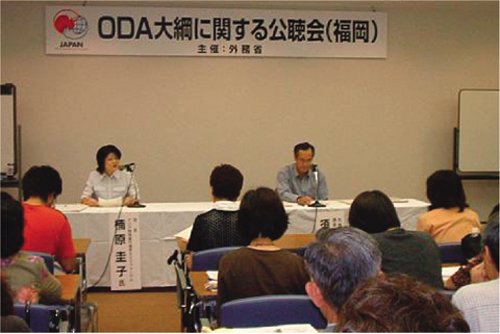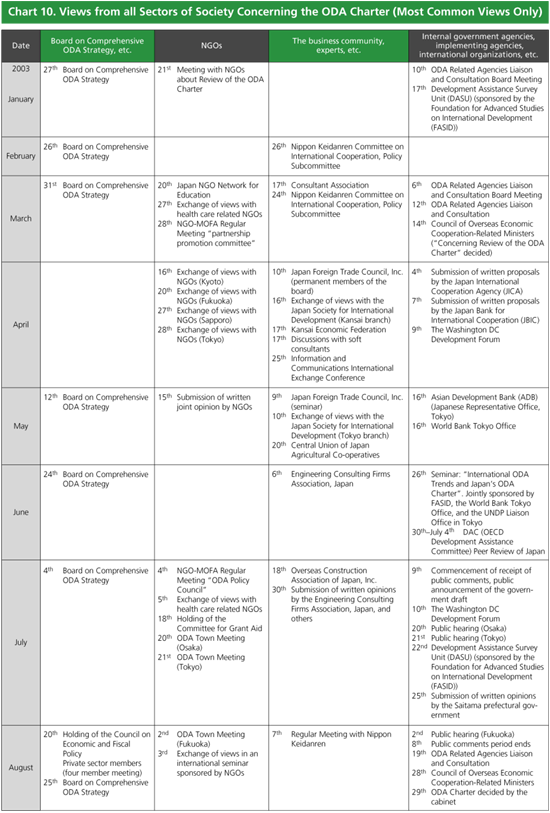
| Part I. |
THE REVISION OF THE “ODA CHARTER” AND JAPAN’S
NEW APPROACH |
Chapter 1
Section 3. The ODA Charter
Revision Process
As stated in the previous sections, the domestic and international situations surrounding Japan’s ODA led to the first revision of the ODA Charter in 11 years. The ODA Charter was revised to enhance the strategic value, mobility, transparency and efficiency of ODA among severe economic and fiscal conditions, encourage the broad public participation, and deepen domestic and international understanding of Japan’s ODA in order that Japan might fulfill its responsibilities commensurate with its national strength against a background of large changes in international trends surrounding development assistance including (1) rapid response to new development issues; (2) strengthening of ODA measures by developed countries; and (3) development cooperation by a variety of assistance providers and deepening of mutual partnership.
The current revision of the ODA Charter was implemented as a compilation of a series of ODA reforms, taking into account changes to the domestic and international situations over these 11 years through study by the government internally and broad discussions including many exchanges of views with experts, implementing agencies, non-governmental organizations (NGOs), the business community, etc., public meetings and hearings, etc. This section explains the ODA Charter revision process.

|
ODA that Advances Together with the Japanese
Public |
In the review of the ODA Charter implemented in fiscal year 2003, the Ministry of Foreign Affairs (MOFA) gave top priority to ensuring transparency in the charter revision process and finding ways to ensure the promotion of public participation, including diverse assistance providers. The review of the ODA Charter was officially announced by Minister for Foreign Affairs Yoriko Kawaguchi in December 2002 and by the Council of Overseas Economic Cooperation-Related Ministers on March 14, 2003, the “Basic policies for the review of the ODA Charter” was issued, and the Council decided that “in addition to deliberations by the Board on Comprehensive ODA Strategy, there will also be broad and exhaustive public debate through hearings with implementing agencies, NGOs, and the business community and through public meetings. The final conclusions will be reached through the deliberations of the Council of Overseas Economic Cooperation-Related Ministers by around the middle of 2003.” The main reason that importance was placed on hearing the views of a broad spectrum of the public is that by sharing the process with people both within and outside Japan, the public’s concerns toward ODA are shared. And it was because it was desirable to clearly communicate Japan’s international cooperation strategy through dialogue and to have Japan’s ODA evaluated appropriately. As a result, the revision of the ODA Charter was carried out in a form never seen in the past in the ODA policy formulation process, by hearing the views of a wide cross-section of the public. Below is an outline of the review process from the perspective of promotion of public participation.
The government carried out the revision of the ODA Charter through study by the government internally, primarily MOFA, and through broad discussions including many exchanges of views with experts, implementing agencies, NGOs, the business community, etc., public meetings and hearings, etc. In the Council of Overseas Economic Cooperation-Related Ministers held on March 14, 2003, the “Basic policies for the review of the ODA Charter” was issued, the major issues up to that date were organized, subsequent discussion was encouraged, and the drafting process was commenced by MOFA. Then, repeated consultations and adjustments were carried out concurrently with organization of the major issues in the review of the ODA Charter by the Board on Comprehensive ODA Strategy, in partnership with the concerned government agencies, and while widely exchanging views with implementing agencies, NGOs, economic organizations, academia, foreign embassies and consulates in Tokyo, etc. Subsequently, with the agreement of 12 government agencies and the three ruling parties, the government draft was completed and in July, the government commenced receipt of public comments on the draft. The deadline for the receipt of public comments was August. A total of 204 comments were submitted through the Internet or by other means. The most commonly submitted opinions were concerned with the relationship between national interest and ODA, the pros and cons of placing importance on ODA to Asia, review of ODA for China, and strengthening the gender perspective of ODA. All of these points were focused upon in discussions during the process of drawing up the government draft. In addition, hearings were held in Osaka, Tokyo, and Fukuoka, and the doubts and views of a variety of participants including people working for NGOs, members of society, students, etc. were directly heard. MOFA kept an official record of the views gathered from public comments and hearings and accepted them as valuable views toward ODA. Then the government amended the government draft and taking into account these opinions and after discussions in the Board on Comprehensive ODA Strategy on August 25, determined the final government draft. Through the Council of Overseas Economic Cooperation-Related Ministers, the revised ODA Charter was approved by the Cabinet on August 29.
After the enactment of the revised ODA Charter, all sectors of the economy both within and outside Japan evaluated the current charter review process. Although most evaluations were positive, there were some opinions stating that it was still unclear to what extent the revised ODA Charter could eliminate previously existing abuses and contribute to making ODA more efficient. The government is aware that people will be watching to see to what extent efficient and effective ODA can be implemented under the revised ODA Charter in the future.
 |
| ODA Charter Hearing (Fukuoka) |
Previous Page | Next Page



